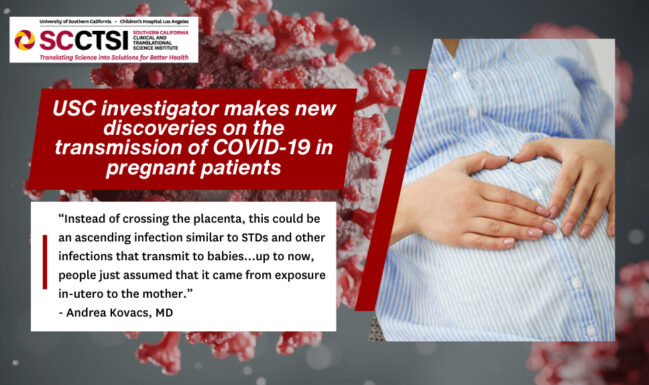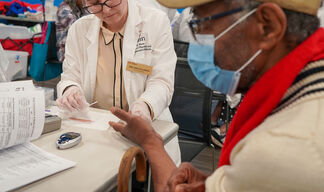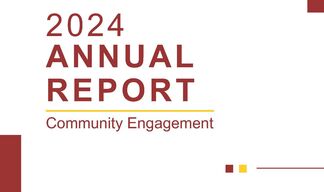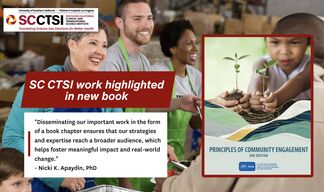USC investigator makes new discoveries on the transmission of COVID-19 in pregnant patients
With help from Biostatistics and Clinical Research Informatics cores, USC investigator contributes to understanding of COVID transmission in utero.
More than four years after the onset of the COVID-19 pandemic, researchers are still shedding light on the consequences of its transmission—one focus being on its relation to pregnancy and fetal health.
Andrea Kovacs, MD, a professor in Pediatrics and Pathology as well as Chief of Pediatric Infectious Diseases at LAC+USC Medical Center and Keck School of Medicine of USC, has extensive experience in clinical research on pathogenesis and transmission of diseases like human immunodeficiency virus (HIV), hepatitis C virus (HCV) and human cytomegalovirus (CMV). However, the HIV program she began at USC was halted in 2020 when she shifted her focus to COVID-19.
“We started working in the COVID-19 field the minute we heard there was this new pandemic,” Kovacs said. “We were allowed to work because we were working on COVID, while all these other labs got shut down.”

The nature of the virus, and its tendency towards prolonged effects despite being characterized as generally temporary, became a reason to focus on certain patient populations.
“This is not considered a persistent virus,” Kovacs said. “But the virus sticks around for at least two weeks, even longer for some people. And it hides out. There's evidence that it may be in the brain and in the heart, renal tissue, and other tissues.”
In the beginning stages of the pandemic, when vaccination rates were still relatively low, this became a glaring problem for pregnant patients and gave rise to Kovacs’ emphasis on transmission through pregnancy.
“I started this project collecting cord blood on all babies born at the hospital, cord blood that is remnant and would be thrown away anyway,” Kovacs said. “Then we started testing all these samples and analyzing the data. That's how I first got to the SC CTSI.”
Kovacs worked with Wendy Mack, PhD, and the SC CTSI Biostatistics, Epidemiology, and Research Design (BERD) core as well as the Clinical Research Informatics (CRI) core for data analyzation and management, an experience that “worked out fantastic,” according to Kovacs.
“From our first meeting with Dr. Kovacs, our team immediately understood the importance of her research,” said Daniella Garofalo, CRI program manager. “Luckily, through the CTSI's partnership with LA County’s Department of Health Services, we could remove her barriers to data access. We leveraged our skilled data analysts and DHS data sources to write complex queries, efficiently extracting the data needed for her analysis. It's an honor to support her work, even indirectly.”
The work that has been published from this study has mostly surrounded the development of new assays for detecting antibodies and variants. COVID-19 can be diagnosed in two ways: antibody testing (for previous infection) and viral testing (for current infection). A common antibody test for COVID looks for Immunoglobulin M (IgM) antibodies (the body’s first response to infection), and a common viral test for COVID is the PCR. Kovacs’ team was conducting Immunoglobulin A (IgA) as well as IgM antibody tests in their data collection.
“IgA and IgM do not cross the placenta,” Kovacs said. “So when you test the baby, it would mean that they made their own antibodies, which is indicative of an in-utero infection.”
The study found a “huge increase” in maternal-baby infection from the Delta to various Omicron variant waves, analyzing data from about 1,400 births across a 15 month period.
“The transmission rate was 22 percent when we started,” Kovacs said. “But in these two peaks for two Omicron waves—that were very infectious, and people got very sick—it went over 30 percent. So, overall it was 20-something percent, much higher than what’s been reported."
Kovacs’ team was also able to pull findings from consenting patient data that highlighted patterns in the birth of these babies with viral infections.
“We’re finding that, among the mothers who have infected babies, they are more likely to deliver late, post-date and they are more likely to have had vaginal deliveries. Somehow, C-section deliveries are protected,” Kovacs said. “We think that, maybe instead of crossing the placenta, this could be an ascending infection similar to STDs and other infections that transmit to babies.”
The discoveries made possible by the innovative assay development by Kovacs’ team, with the analytical help of the CTSI’s BERD Core, highlights room for future research and development for treatments to combat the ever-evolving strains that make up the COVID-19 virus.
“Working with Dr. Kovacs' team was both exciting and challenging.It was a dynamic environment where you had to think on your feet and get creative because new ideas and proposals were always on the table,” said BERD statistician Amila Adili. “My job involved pulling together complex raw data from scratch to review Dr. Kovacs' team’s work, and coming up with additional statistical evidence to support what might be an underestimated IU-SC prevalence. It was rewarding to develop new strategies for analysis as we went along—this role really pushed my skills and brought a lot of growth."
Kovacs is continuing to work with the CTSI on the next stage of this study, looking towards the future for the infected babies’ development patterns.
“The CTSI allowed us to get all this data that we were unable to, like vaccine data from the state level and databases from the county. They’re able to get literally everything we need to analyze these relationships, and I would definitely recommend them to other people,” Kovacs said. “With the data analysis group, we’re analyzing all of the maternal clinical factors at birth and at delivery, and we’ve also gathered data on the babies up to a year of age so far. We’re going to try for at least two or three years to see if there’s any developmental abnormalities—differences between those infected and those not infected.”
According to Kovacs, future directions could involve looking closer at the IgA antibodies found in the baby, which could be “protective” in their neutralizing affinity, preventing the baby from becoming very sick. There is also the possibility that the level of antibodies “may impact whether a baby gets central nervous disease,” and Kovacs intends to look into these nervous system abnormality reports in her investigation into child development after maternal transmission.
“I think this project is fascinating. I’ve been completely obsessed with trying to get to the answer because, if it's true, years down the line we may see some really bizarre developmental problems, neuropsychiatric problems,” Kovacs said. “Up to now, people just assumed that it came from exposure in utero to the mother and her cytokines and everything in her immune system being out of whack. The next step is to first validate our findings, then after that, develop treatment strategies.”



